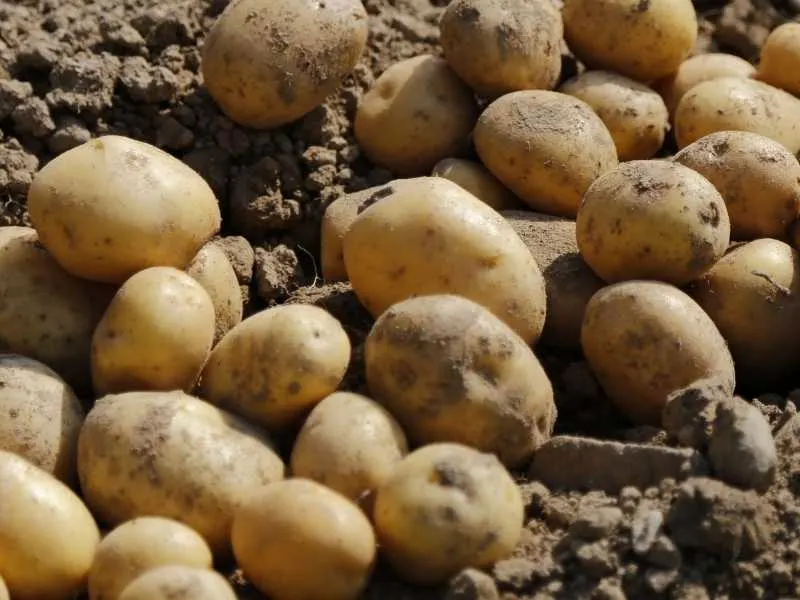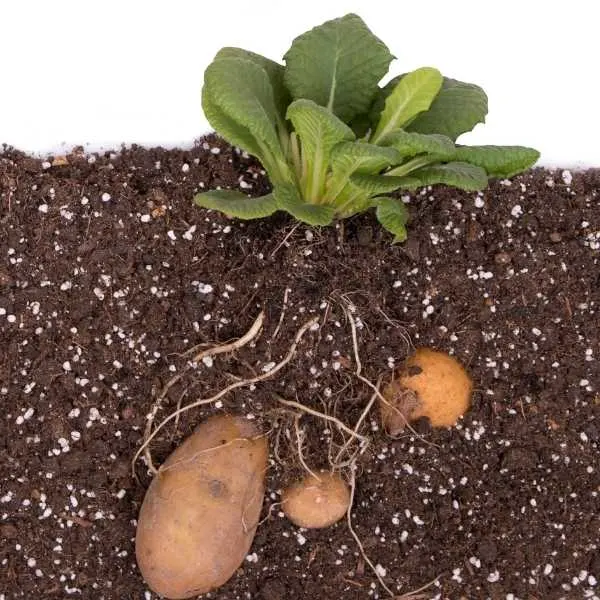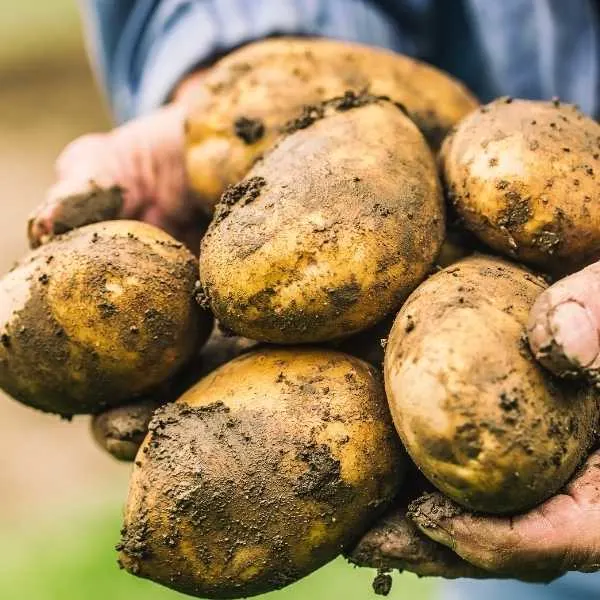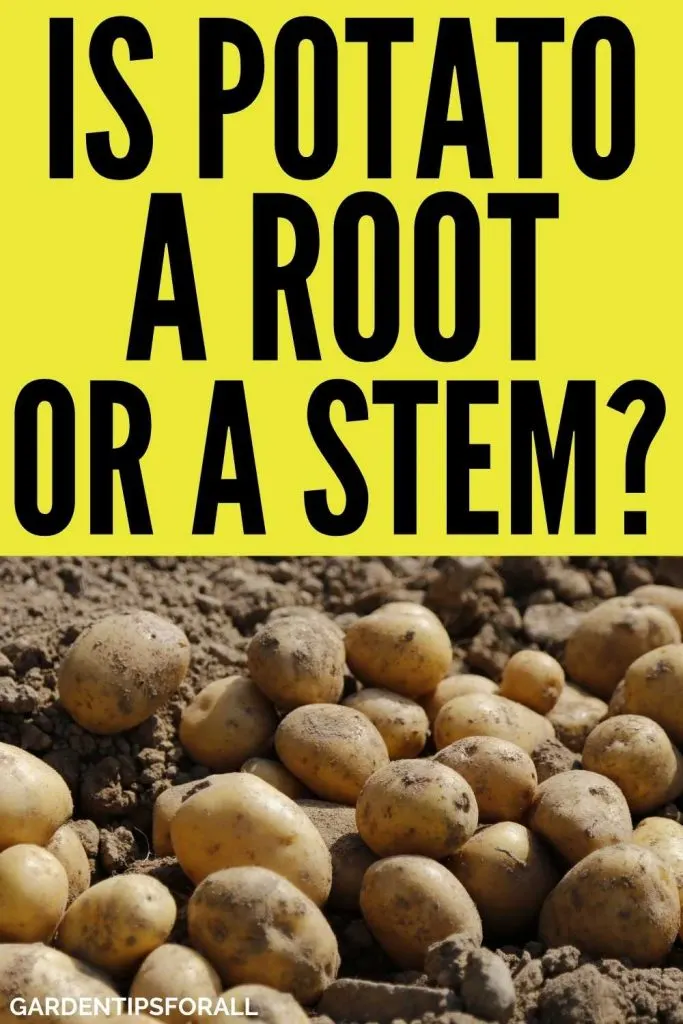Is Potato a Root or a Stem?
Most people assume that potatoes are roots because they grow underground. Well, we can’t blame anyone who thinks so since most of the things that grow underground are roots.
However, others believe it’s a stem. So which one is it? Is potato a root or a stem?
Potato is definitely not a root, and it’s not really a stem. It’s a modified stem known as a tuber. Tubers develop from an underground stem known as a stolon, and they act as storage for food/starch for later use by the plant.

Keep reading to find out more about potatoes and what makes them tubers.
Before we discuss how tubers work, let’s first take a brief look at what the potato is and how potatoes grow.
About the Potato (Solanum Tuberosum)
Potatoes are perennial vegetables whose cultivation dates back up to 10,000 years ago. They are believed to have originated in Peru, South America, before they spread to other parts of the World.
Today, potatoes are some of the most cultivated vegetables worldwide and some of the largest food crops. Even though they originated from Peru, Northern Europe remains the leading producer of potatoes.
There are more than 4000 known potato species.
Potatoes are generally herbaceous, with stems that grow up to 24 inches in height, green leaves, and flowers. The flowers can be white, blue, red or pink, but they all have yellow stamens.
Once the potato plant matures, the leaves die (turn to a brownish color), and the flowers turn to fruits.
The fruits, leaves, and stems contain alkaloid solanine which is toxic to humans. The only part that’s safe to eat is the tubers.
However, the tubers also contain toxic glycoalkaloids, but in small amounts.
Glycoalkaloids offer protection against sunlight and pests. But if you expose the potatoes to too much sunlight, the toxic levels could rise to a point where they are harmful to humans.
How Tomatoes Grow

You grow potatoes from seed potatoes, which are the tubers kept for some time until they develop some sprouts.
You can develop these seed potatoes yourself or buy treated ones from a certified supplier. But when developing new varieties, the seeds from the fruits are used.
Potatoes grow in 5 phases. The first phase is where the seed potatoes develop sprouts.
These sprouts develop and photosynthesize to produce food, allowing the stems to grow above the ground and the stolons to grow into the ground.
This type of growth continues in the third phase, where more stolons are produced, and they start swelling (forming tubers), and the plant keeps growing above the ground and producing the flowers.
At a point, totato plants cease growing and start “packing up” more food in the swollen section of the stolons.
And in the last phase, the tubers mature while the rest of the plant dies.
Potatoes can produce up to 20 tubers on a single stolon without much effort from the farmer.
What is a Tuber, and Why are Potatoes Tubers?

As mentioned earlier, tubers are types of modifications that occur on stems.
Modifications occur on various parts of a plant as it adapts to the environment. These modifications are also known as geophytes.
Tubers are enlargements that develop to store nutrients for the whole plant.
These nutrients can then be used by the plant later. These modifications also facilitate perennation (allowing plants to survive during unfavorable seasons), and they can also help in asexual production or propagation.
There are two types of stem tubers. Some stolons grow horizontally, such as in potatoes, and thickened rhizomes that are simple underground stems.
A tuber is a regenerative organ whereby, once the plant dies, this tuber can regenerate by developing new shoots. This description fits what I just described about potatoes.
Why is a Potato a Stem and Not a Root?
Potatoes are considered stems because tubers comprise all parts of a typical stem. This includes nodes, internodes, terminals, axillary buds, pedicels, and petioles.
Below is how each of these parts functions courtesy of Science Facts:
- Nodes – This is the part where stems, leaves, buds, and other crucial elements of a plant develop. They also support the plant and facilitate the healing of a plant after injuries.
- Internodes – This is the “zone” that connects two nodes. It facilitates the transport of food, water, and minerals between the nodes. The larger the internodal zone, the taller the plant, or the larger the potato in this case.
- Terminal Bud -This is the bud that controls the vertical growth of a plant. It prevents the development of more buds, ensuring a plant can grow vertically, also known as apical dominance.
- Lateral Bud – Lateral buds develop at the section between the petiole and the stem. Lateral buds are often dormant, but they can develop into leaves, stems, or flowers.
- Petiole – This is the stalk that connects the leaves and the nodes. They facilitate the transport of water and minerals to the leaves and food transport from leaves to other parts of the plants after photosynthesis.
- Pedicel – This is the stalk that connects a flower to the stem. They conveniently support the flowers to allow pollination by insects.
- Leaves -Leaves are the broad, thin structures that appear along and at the end of a petiole. They are the primary organ that develops from the node. Most leaves are green, including potato leaves, and they help in photosynthesis, transpiration, and respiration.
- Flowers -This is the part that facilitates pollination and sexual production in plants. Flowers come in different colors and are located at the end of a pedicel.
Let’s Take a Look at these Parts in a Potato
The nodes and internodes of a potato occur all around it, and they are arranged spirally. These nodes are often referred to as the “eyes.”
Potato tubers also feature a leaf scar, which is the part where it connects to the stolon, while the terminal bud appears on the other end to complete the ‘stem.’
When the bud is allowed to regenerate, shoots develop from the nodes ( “eyes”).
Once these shoots develop, adventitious roots develop at the part where the shoot connects to the tuber. And lateral buds start developing on the shoots.
Petioles form on the shoots, as well as the leaves. And as mentioned earlier, potatoes also have flowers that often grow into fruits.
Besides Irish potatoes, yams are another excellent example of stem tubers.
Is Sweet Potato a Root or Stem?

The potatoes I’ve been discussing all along are the Irish potatoes, also known as white potatoes.
Even though they share a name with sweet potatoes, they belong to a different family.
One major difference between the two is that Irish potatoes are stem tubers while sweet potatoes are root tubers.
Secondly, Irish potatoes are grown from seed potatoes while sweet potatoes are grown from small seedlings developed from growing sweet potatoes. These seedlings are known as slips.
Root tubers are modified roots, which also act as storage organs for the whole plant.
Just like in stem tubers, root tubers store the food for use in future growing season. After a growing season, the plant dies and develops new shoots in the next season.
Another difference is that sweet potatoes lack nodes, internodes, and all other features that make the Irish potato a stem.
Cassava is also another good example of a root tuber.
Other Types of Stem Modifications
Below are other modified stems you may have come across;
- Bulbs – This is a type of modified stem where the actual stem is a flat base, and leaves develop from a node at this base one over the other, enclosing a bud in the middle. These leaves are hollow, but they later fill up with food from the plant and swell. Good examples are onions and garlic.
- Rhizomes -Rhizomes are modifications that grow horizontally underground. These rhizomes contain nodes from which roots develop into the ground, and shoots develop above the ground. A good example is ginger.
- Corm -Corms are slightly similar to bulbs because they both store food in a vertical stem. However, unlike the bulbs, corms have one solid structure instead of several concentric rings. While bulbs have live fleshy leaves, corms consist of dead leaves that form a tunic around the corm. This tunic offers protection against insects, waterlogging, and water loss.
Frequently Asked Questions
Are Potatoes Legumes?
Not really. You may assume that because potatoes have nodes, they qualify to be called legumes. But the difference lies in how they are formed. In legumes, nodes develop when the root nodules interact with nitrogen-fixing bacteria. In tubers, nodes are a result of starch storage.
Which Part of a Potato is Edible?
Only the tuberous section of the potato is edible. It stores starch and makes a good vegetable to add to a wide variety of recipes. The leaves, stems, and fruits are toxic to humans.
Conclusion
I hope that clears everything up. Potatoes are stems or modified stems to be more precise. The fact that they have nodes, internodes, terminal bulbs, lateral buds qualifies them as a stem and not a root. On the other hand, sweet potatoes are roots since they are a different type of tuber that lacks the features of a stem and stores food in the roots.
Related Article:

